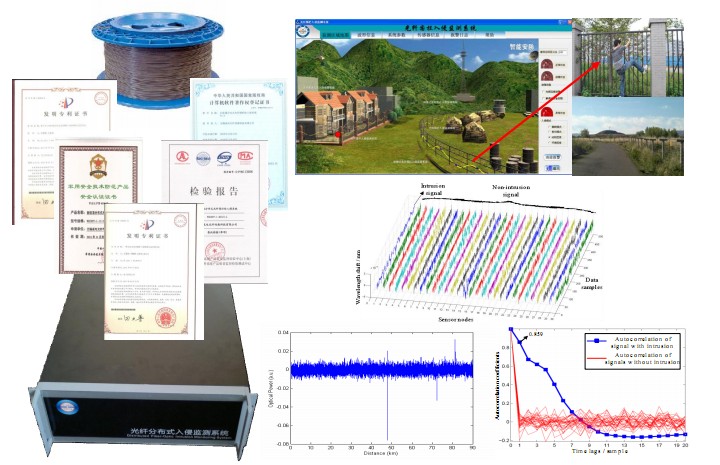

Highlight
Sensing Signal Extraction and Processing for Fiber-Optical Fences

Fiber-Optical Fences have outstanding advantages of long distance transmission, high sensitivity, passivity, and electro-magnetic immunity, and et al, thus it can be quite a promising option for many important safety monitoring areas, such as long-distance national border security, oil and gas pipelines and large civil structures monitoring and so on.
In our group, three major techniques of fiber-optic fences are all covered, including the highly sensitive Mach-Zehnder Interferometer, quasi-distributed optical fiber fences based on the FBG strain and vibration sensor network and the OTDR-based fully distributed optical fiber fences. All the above perimeter intrusion monitoring systems have achieved considerable success especially in recent years. Concerning Phase-sensitive Optical Time Domain Reflectometry (Φ-OTDR)-based distributed optical fiber fences, the sensing distance can reach up to 138 km with a good spatial resolution of 15m without any a repeater, which has broken the international records in 2013. In addition, weak signal detection and location in complicated noisy background, Signal-Noise separation, feature extraction and intrusion pattern recognition have also made big progresses. And related results have been published in Sensors and Actuators A: Physical, Acta Physica Sinica, et al. And lots of Chinese invention patents have been authorized as well. Besides, the optical fiber fence series products have passed the inspection committed by Test Laboratory of Security and Crime Prevention and information security Products and Systems of the Third Institute of the Ministry of Public Security, and also got the military security product certification from Chinese People's Liberation Army Products Miliary Security Certification Center. And they have been well applied in protection of a section of Chinese borderline of nearly 220km from 2012, and domestic transformer substation in China from 2011, and some of them have also been exported to Pakistan and other places.
This research has been supported by National High Technology Research and Development Program of China (863 Program, Grant No. 2007AA01Z245), the Major Program (Grant No. 61290312) and Youth Foundation (Grant No. 61301275) of the National Science Foundation of China (NSFC), and the Fundamental Research Funds for the Central Universities (Grant No. ZYGX2011J010). This work is also supported by Program for Changjiang Scholars and Innovative Research Team in University (PCSIRT, IRT1218), and the 111 Project (B14039).the Program for Changjiang Scholars and Innovative Research Team in University (Education Ministry of China).
In our group, three major techniques of fiber-optic fences are all covered, including the highly sensitive Mach-Zehnder Interferometer, quasi-distributed optical fiber fences based on the FBG strain and vibration sensor network and the OTDR-based fully distributed optical fiber fences. All the above perimeter intrusion monitoring systems have achieved considerable success especially in recent years. Concerning Phase-sensitive Optical Time Domain Reflectometry (Φ-OTDR)-based distributed optical fiber fences, the sensing distance can reach up to 138 km with a good spatial resolution of 15m without any a repeater, which has broken the international records in 2013. In addition, weak signal detection and location in complicated noisy background, Signal-Noise separation, feature extraction and intrusion pattern recognition have also made big progresses. And related results have been published in Sensors and Actuators A: Physical, Acta Physica Sinica, et al. And lots of Chinese invention patents have been authorized as well. Besides, the optical fiber fence series products have passed the inspection committed by Test Laboratory of Security and Crime Prevention and information security Products and Systems of the Third Institute of the Ministry of Public Security, and also got the military security product certification from Chinese People's Liberation Army Products Miliary Security Certification Center. And they have been well applied in protection of a section of Chinese borderline of nearly 220km from 2012, and domestic transformer substation in China from 2011, and some of them have also been exported to Pakistan and other places.
This research has been supported by National High Technology Research and Development Program of China (863 Program, Grant No. 2007AA01Z245), the Major Program (Grant No. 61290312) and Youth Foundation (Grant No. 61301275) of the National Science Foundation of China (NSFC), and the Fundamental Research Funds for the Central Universities (Grant No. ZYGX2011J010). This work is also supported by Program for Changjiang Scholars and Innovative Research Team in University (PCSIRT, IRT1218), and the 111 Project (B14039).the Program for Changjiang Scholars and Innovative Research Team in University (Education Ministry of China).
